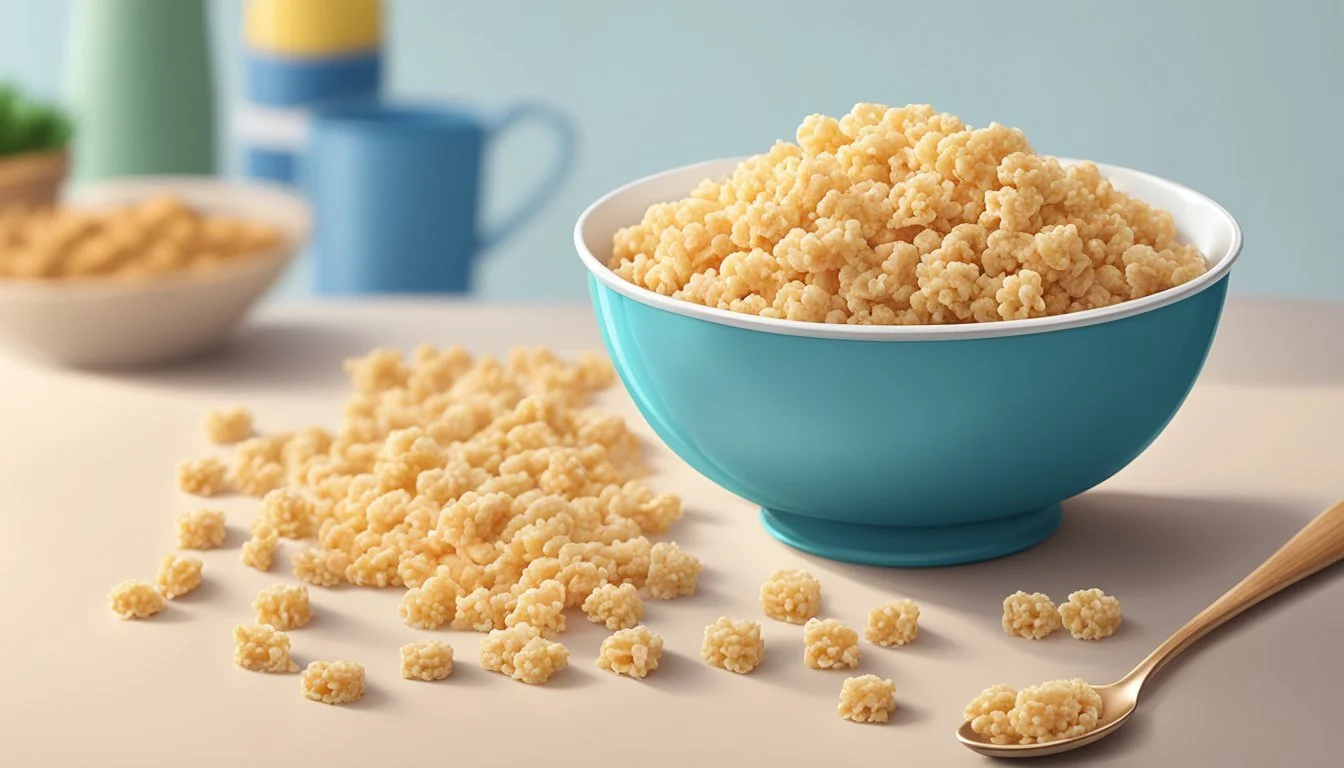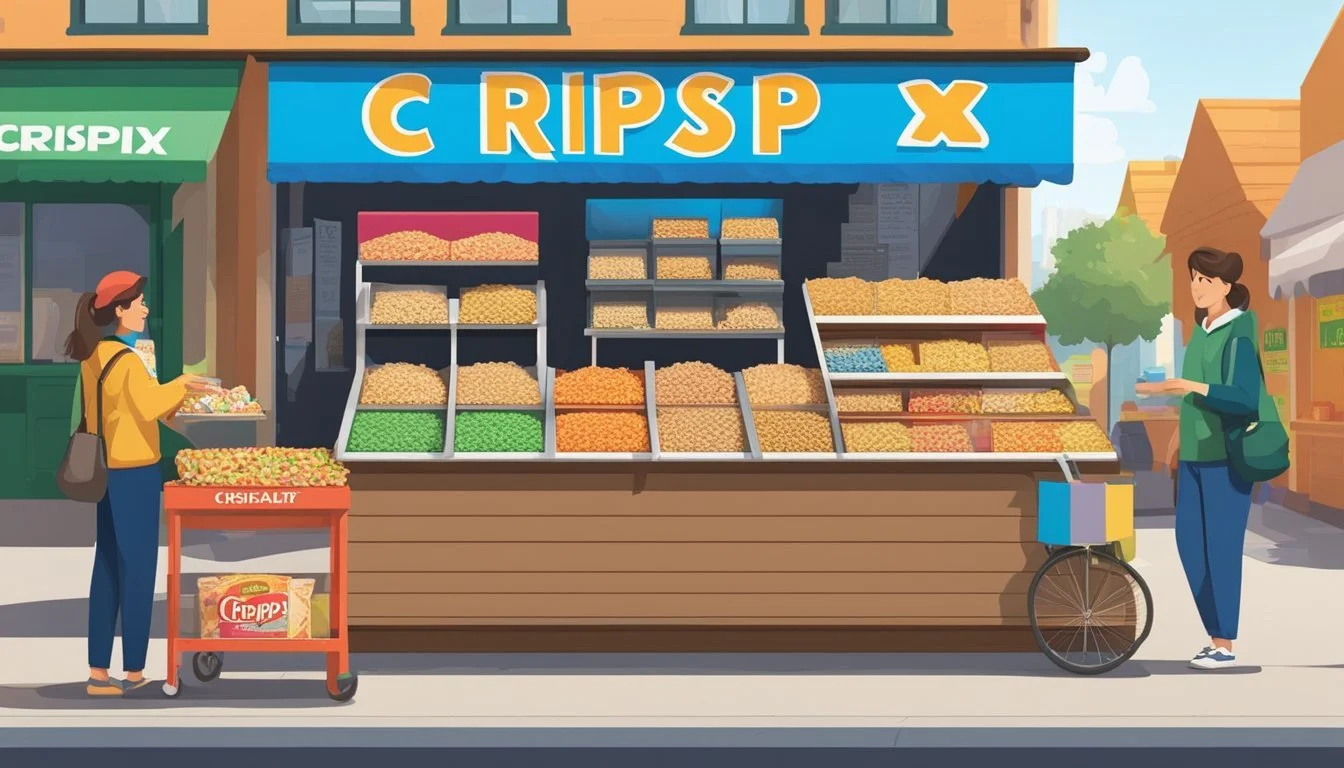Crispix vs Rice Krispies
Comparing Popular Breakfast Cereals
This Article is Part of Our Breakfast Cereal Guide with Details on Crispix Nutrition and Rice Krispies Nutrition
When choosing between breakfast cereals, many often find themselves debating between Crispix and Rice Krispies. Both cereals hail from Kellogg’s and have earned their place in many households as a breakfast staple. When comparing the two, Crispix has 21.0 grams of complex carbohydrates per serving, whereas Rice Krispies has 22.0 grams. This minor difference can influence which cereal might be a better fit depending on dietary needs.
Crispix is unique with its combination of corn and rice, resulting in a crispy texture that many enjoy. In contrast, Rice Krispies are known for their distinct pop and crackle, a characteristic that has made them popular for years. Both cereals have their loyal followers, each swearing by the taste and texture of their preferred choice.
Health-conscious consumers might also weigh other factors like sugar content, calorie count, and potential antioxidants present in each cereal. While nutritional differences might be slight, these can still make a significant impact depending on one's dietary goals.
Origin and Manufacturer
Crispix and Rice Krispies are two popular breakfast cereals manufactured by Kellogg's. Both have distinct origins and historical backgrounds.
History of Crispix
Kellogg's introduced Crispix in 1983. It was developed to compete with the Chex family of cereals produced by Ralston Purina, which was dominating the market at the time.
Crispix features an innovative design with crispy rice on one side and crunchy corn on the other. This dual-texture distinguishes it from other cereals.
By 1987, Crispix had achieved significant commercial success, with sales reaching around $65 million. The cereal remains a staple in Kellogg's lineup and is known for its unique texture and taste.
History of Rice Krispies
Rice Krispies has a long history, dating back to its introduction by WK Kellogg Co in 1928. Known as Rice Bubbles in some markets, this cereal is made of crisped rice that makes a distinctive "snap, crackle, and pop" sound when milk is added.
The culinary impact of Rice Krispies extends beyond just breakfast bowls. In the 1930s, a Kellogg's employee created the iconic Rice Krispie Treats, further cementing the cereal's place in popular culture.
Produced in Kellogg's Battle Creek, Michigan plant, Rice Krispies continues to be a beloved choice among consumers for its simplicity and nostalgic value.
Cereal Composition
Crispix and Rice Krispies differ in several ways when it comes to their ingredients and nutritional content. Understanding these differences can help you make an informed decision on which cereal best meets your dietary needs.
Ingredients Profile
Crispix is made from a combination of rice and corn, while Rice Krispies consists solely of rice. This difference in base ingredients contributes to the distinct textures and flavors of each cereal.
Crispix tends to be crisper and maintains its crunch longer in milk. Rice Krispies, on the other hand, are known for their iconic "snap, crackle, pop" sound.
Both cereals contain sugar, salt, and malt flavoring among other minor ingredients, but Crispix typically includes a slightly wider variety of additives due to its dual-grain composition.
Nutritional Content
When it comes to nutritional content, there are notable differences. Crispix provides more dietary fiber, with about 1.0 grams per serving compared to Rice Krispies, which contains negligible amounts.
Calories and Fat:
Crispix: 110 calories, 0.5 grams of fat per serving.
Rice Krispies: 130 calories, 0 grams of fat per serving.
Sodium:
Crispix: 220 milligrams per serving.
Rice Krispies: 290 milligrams per serving.
Protein:
Crispix: 2 grams per serving.
Rice Krispies: 2 grams per serving.
Crispix tends to be slightly richer in certain vitamins and minerals like Iron and Folate. Conversely, Rice Krispies often have added vitamins including Vitamin D and B12 in higher quantities.
Each cereal has its unique benefits and drawbacks, making the choice largely dependent on individual nutritional priorities and taste preferences.
Health and Dietary Considerations
Crispix and Rice Krispies are breakfast cereals with distinct nutritional profiles. This section will detail their caloric contents and their fit within a balanced diet, touching on key nutrients and health implications.
Caloric Comparison
Crispix and Rice Krispies have similar calorie counts per serving. Crispix contains about 110 calories per serving (1 cup), while Rice Krispies have approximately 100 calories for the same serving size. This slight difference can help guide calorie-conscious consumers in their choices.
Nutrient Content is crucial for a comprehensive comparison. Crispix provides 3 grams of sugars and 21 grams of complex carbohydrates per serving. Rice Krispies also have 3 grams of sugars but lack significant complex carbs.
Dietary Fiber is a point of distinction; Rice Krispies contains 0 grams of dietary fiber, whereas Crispix offers a modest amount, aiding in digestion.
Balanced Diet Integration
Incorporating these cereals into a balanced diet involves evaluating their vitamin and mineral content. Crispix is enriched with higher levels of several vitamins and minerals such as Iron, Vitamin B6, Vitamin B12, Zinc, and Copper compared to Rice Krispies, making it a more nutrient-dense option.
Rice Krispies, typically lower in these nutrients, rely on fortification for vitamins like Vitamin D and Vitamin C. While both cereals are low in fat and provide moderate protein levels, the added nutrients in Crispix may support broader dietary needs.
For those with dietary restrictions, the ingredient profiles matter. Both cereals contain no gluten, making them Gluten-Free, but allergens like soy in processed products should be noted. Balancing sodium, potassium, and other electrolytes is also key in managing dietary health.
Market Presence and Availability
Crispix and Rice Krispies have carved out significant niches in the cereal market with unique consumer preferences and extensive retail distribution networks. Both cereals are popular in the United States, each with distinct characteristics that appeal to different customer segments.
Consumer Preferences
Consumers have varying preferences when choosing between Crispix and Rice Krispies. Crispix is often favored by those looking for a cereal with 21 grams of complex carbohydrates per serving, which appeals to individuals seeking detailed nutritional information. In contrast, Rice Krispies, with 22 grams of complex carbohydrates per serving, attracts consumers who enjoy its distinctive "snap, crackle, and pop" texture and sound.
Rice Krispies also have a legacy of being a versatile ingredient for homemade treats, boosting its popularity. According to cereal ratings and publications, the nostalgic factor and recipe versatility play significant roles in consumer choices.
Retail Distribution
Both cereals are widely distributed across various grocery stores in the United States. Crispix and Rice Krispies can be found in major chains like Walmart, Target, and Kroger, as well as smaller regional grocery stores. The strategic placement in multiple retail outlets ensures broad access for customers.
Despite this extensive distribution network, Rice Krispies faced a temporary shortage earlier in the year due to production setbacks. This created a notable impact on availability, highlighting the importance of consistent supply in maintaining market presence. Monitoring sales data and adjusting distribution strategies are crucial for both brands to meet consumer demand effectively.
Product Variations
Crispix and Rice Krispies offer several product variations including derivative treats and alternative cereals. Each product provides unique benefits and ingredients to cater to different tastes and dietary requirements.
Rice Krispies Treats and Other Derivatives
Rice Krispies have expanded their brand with several derivatives such as Rice Krispies Treats. These beloved treat bars are made from Rice Krispies Cereal and marshmallows, creating a sweet and chewy snack for all ages. They are available in various flavors such as chocolate and butterscotch.
Another version is the Rice Krispies Treats Cereal, which features bite-sized pieces of Rice Krispies Treats. This cereal aims to capture the treat's essence in a breakfast format, offering a more indulgent option for morning meals. Additionally, homemade variations of Rice Krispies Treats often include mix-ins like pretzels, M&Ms, and nuts, as suggested by enthusiast recipes.
Competing Products and Alternatives
There are several competing products and alternatives to Crispix and Rice Krispies. General Mills Rice Chex serves as a prominent alternative, known for its versatility in recipes like Chex Mix. Golden Grahams and Cinnamon Crunch are also noteworthy as they provide a different flavor profile while still catering to cereal lovers.
For those who prefer a chocolate flavor in their cereal, Cocoa Krispies offers a rich taste. Lucky Charms combines cereal with marshmallow bits, appealing to both children and adults alike. Additionally, Cereal Bars such as those made with Crispy Rice can be convenient snacks, providing portability without sacrificing taste.
Through these variations and competing options, consumers have a wide variety of products to choose from, ensuring there is something to meet nearly every preference.
Serving Size and Packaging
Both Crispix and Rice Krispies offer standardized serving sizes and package weight, but key differences can be noted regarding the number of cups per box and nutritional specifics.
Measurements and Weight
Crispix and Rice Krispies come in varied package sizes, typically measured in ounces. A standard box of Rice Krispies weighs about 15 ounces, providing roughly 10 cups of cereal. For Crispix, similar packaging is available, often around 14 ounces per box.
Serving sizes also vary:
Rice Krispies: One serving is typically 1 1/4 cups, weighing about 33 grams.
Crispix: One serving is around 1 cup, weighing 27 grams.
These slight differences in weight and volume can affect daily nutritional intake.
Consumer Convenience
Packaging plays a significant role in consumer convenience. Both cereals are often sold in resealable bags within the boxes, aiding in freshness. Families or larger households benefit from bulk packaging.
Key features for consumers:
Number of Cups per Box: Rice Krispies provide about 10 cups per 15-ounce box. Crispix offers 8-10 cups, depending on box size.
Serving Details: Rice Krispies focus on portions measured by cups, while Crispix emphasizes weight in grams.
These factors ensure ease in meal planning and portion control.
Brand Icons and Marketing
Both Crispix and Rice Krispies are notable cereals produced by the Kellogg Company, known for their distinctive branding and marketing strategies.
Character Mascots
Rice Krispies are synonymous with the mascots Snap, Crackle, and Pop. These characters have been integral to the brand since their introduction in the early 1930s.
Snap, Crackle, and Pop are depicted as gnomes who bring the iconic "snap, crackle, pop" sound to life, enhancing brand recognition. They have appeared in countless advertisements and packaging designs, making them household names. Their presence on social media platforms has further cemented their role in contemporary advertising.
Crispix, on the other hand, does not utilize character mascots to the same extent. Instead, its marketing has focused more on the product's unique dual-texture: one side corn, the other side rice. This approach highlights the product’s unique selling proposition rather than relying on mascots.
Advertising Strategies
Kellogg's employs diverse advertising strategies for both Crispix and Rice Krispies. Rice Krispies has leveraged multimedia campaigns extensively. For instance, the brand has utilized YouTube Director Mix to create personalized video advertisements which significantly outperformed traditional banner ads.
The brand also maintains a strong presence in digital and social media marketing. Over 439 million social media posts by influencers have featured Rice Krispies, making it a powerful tool for engaging with younger audiences.
Crispix’s advertising has focused on its health benefits and distinctive texture. Marketing efforts often highlight its lower sodium content and dietary fiber properties compared to other cereals. Traditional media such as television ads and print advertisements emphasize these attributes to appeal to health-conscious consumers.
Thus, while both cereals benefit from the strong brand heritage of Kellogg's, their marketing tactics differ to suit their unique selling points.









